Diversity and Plasticity in Mosquito Feeding Patterns: A Meta-Analysis of ‘Universal’ DNA Diet Studies
Abstract
Aim
Although mosquitoes can have innate preferences for particular blood-meal hosts, their realised feeding patterns on different host species can be modified under climate and land use change with implications for disease spread. Therefore, it is important to understand the niche breadth of vectors and the extent to which shifts in feeding patterns can be predicted.
Location
Global.
Time Period
2000–2019.
Major Taxa Studied
Six prominent disease-vectoring mosquitoes: Aedes aegypti, Ae. albopictus, Anopheles funestus, An. gambiae, Culex pipiens, Cx. quinquefasciatus.
Methods
Focusing on blood-meal studies that used ‘universal’ molecular methods with broad taxonomic coverage, we compiled evidence from > 15,600 blood-meals. We estimated mosquito's host niche breadth and we used hierarchical Dirichlet regression models to investigate shifts in feeding patterns among different functional and taxonomic groups of host species in relation to host and environmental factors.
Results
We estimated host ranges of 179–321 species for each of the two Culex mosquitoes and 26–65 species for Aedes mosquitoes, comprising considerably broader host niche breadths than previously anticipated. For the two Anopheles species, we estimated host ranges of 7–29 species. We found some evidence that shifts in feeding patterns among different host functional and taxonomic groups were associated with environmental conditions such as temperature and livestock density, while our results also demonstrate that with the currently available evidence, global predictions of shifts in mosquito feeding patterns are impeded by significant uncertainty.
Main Conclusions
Our global meta-analysis afforded first insights into the shifts of feeding patterns in variable environments, suggesting that host choice is not a simple function of host availability, but contingent on other environmental drivers. Improving resolution and consistency of data gathering and reporting will improve the precision of how blood-meal studies can inform us of present and potential risks of pathogen transmission events.


 求助内容:
求助内容: 应助结果提醒方式:
应助结果提醒方式:


